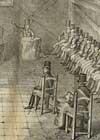Carbonari
Napoleon's slow fall in 1813-1815 left many European regions in an unstable situation: a simple return to the ancien régime was impossible, yet there were no viable alternatives in sight. As a result, the years of 1815-1830 were marked by a virtually uninterrupted series of political assassinations, military conspiracies, and popular revolts in Spain, France, a number of German and Italian states, Greece, Russia, the Netherlands, and Poland; and as a matter of course, the names of secret societies were linked to all of those events. Pride of place was given to the Carbonari of the kingdom of the Two Sicilies. This was due to the time they had existed (going back to just after the French occupation of Naples in 1806), their size (it was really a large movement, which even included priests in spite of the interdict by the Church), and the almost perfect image of the romantic rebel they evoked. The origins of the 'coal-burners' remained obscure, but there was a clear similarity to the graded organization and initiation rites of Freemasonry, which to conservatives had been the instrument of choice of the Illuminati in bringing about the French Revolution. This impression was only confirmed when the Carbonari actually came to play an important role in the Italian insurrections of 1820-1821. Ever since, the term carbonaro was used to designate a revolutionary conspirator all over Europe.
We know several program documents of the Carbonari. Their rules were quickly translated into French by Edme-Théodore Bourg (1785-1852), a one-time secretary to Napoleon's marshal Berthier, who wrote under the name of Saint-Edme. His text is much the same as the Italian version published by Alessandro Luzio in Il processo Pellico-Maroncelli (1903).
Read also the rules of the Carbonari. (Pdf 128 Kb)
Source: Saint-Edme, Constitution et organisation des Carbonari, ou Documens exacts sur tout ce qui concerne l'existence, l'origine et le but de cette société secrète, 2nd ed, Paris: Brissot-Thivars, 1822, pp 41-89. (Call number: It63/4).

